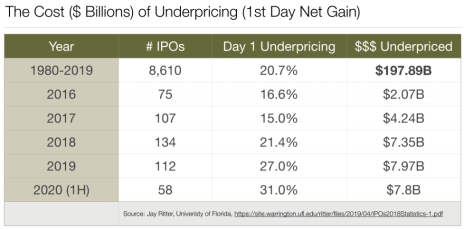“SPACs,” or special purpose acquisition companies, are the rage these days. SPACs are formed and go public for the sole purpose of raising capital used to merge with or acquire another company.
They’re so popular because they are generating big fees for banks, raising substantial capital for entrepreneurs, and in some cases, big returns for investors. The key factor that enables a SPAC to raise significant capital by going public before its management team has even identified a business to acquire is the credibility and track record of the management team.
Through November 2020, over $62.5 billion has been raised by SPAC IPOs this year, 366% more than last year and the highest amount ever.
Renaissance Capital studied 313 SPAC IPOs since the start of 2015. They found:
“93 have completed mergers and taken a company public. Of these, the common shares have delivered an average loss of -9.6% and a median return of -29.1%, compared to the average aftermarket return of 47.1% for traditional IPOs since 2015. Only 29 of the SPACs in this group (31.1%) had positive returns.”
Is this time different?
In other words, has something changed in the market that makes SPAC investing more attractive?
First, let’s explore the positives.
The Pros of SPAC Investing
Many, including famous venture capitalist Bill Gurley of Benchmark Capital, argue that the initial public offering (IPO) process is broken.
Investment banks typically underprice the offering price of companies going public. This results in an IPO pop.
From 1980 to 2019, IPOs were underpriced by an average of 20.7%.
Who does this benefit? The favorite clients of the investment banks involved in the pricing. It keeps those customers coming back again and again.
Even though the IPO pop has historically been celebrated, it’s really a negative for the issuing company, as it shows that the company left money on the table.
If you view the IPO pop as part of the company’s cost of capital, it is exceedingly expensive. IPO fees paid to lawyers and underwriters typically add up to 7%. Add the 20.7% IPO pop and the “cost” of going public is an egregious 27.7% on average.
With that backdrop in mind, going public via a SPAC is an attractive alternative for companies considering an IPO. It’s a lot cheaper than an IPO and significantly faster (two months vs. six months for the typical IPO process).
Now it’s time for the negatives.
The Cons of SPAC Investing
For most SPACs, founders get to keep 20% of the equity so there is considerable dilution for the company that has been acquired.
Also, the SPAC sponsor only gets to keep their 20% if they consummate a deal within two years. Otherwise, they must return the capital. Thus, it’s in their interest to consummate a deal at almost any price.
Plus, there are so many SPACs in the market today that popular private companies have many SPAC suitors.
As a result, popular private companies can set up “SPAC-offs,” where various SPACs pitch their deal, competing mostly on price.
This is all well and good for the company that is being acquired, but it is bad for investors in the SPAC. The higher the acquisition price, the lower the future return SPAC investors can expect.
The below quote from Don Keough, a director at Coca-Cola from 1986 to 1993, speaks to the “animal spirits” that can be unleashed when SPACs compete for deals.
“In the field of mergers and acquisitions, multi-million, even billion-dollar deals get under way, and the momentum builds, the rivalries among the players come to the fore, the game goes ahead, no holds barred. Someone is determined to win! They can taste it! All the cash lying on the table, all the supposedly solid rationale behind the deal, all the people involved—nothing matters except winning! ‘I want my way,’ says the biggest ego in the room! There are dreams of being in the press conference spotlight and big headlines in the Wall Street Journal. It’s all too glamorous, and we convince ourselves that the numbers do add up—even when they are about as sound as astrological predictions. The ‘animal spirits’ that John Maynard Keynes wrote of are more powerful than most business people would like to admit.”
This mentality is why SPACs should be viewed with extreme caution. But they shouldn’t be written off completely.
My sense is SPACs are here to stay and represent a very viable alternative to an IPO.
Further, I think SPAC terms will change with time and become more attractive to investors. For example, SPAC sponsors typically get to keep 20% of the equity in the vehicle if a deal is consummated. However, that percentage is negotiable.
Recently, Bill Ackman of Pershing Square launched a SPAC but his takeaway is 0%. This is incredibly attractive for investors for two reasons. First, it eliminates dilution, and second, it removes the incentive to complete a deal at any price.
I think SPACs are here to stay this time. Just do your research and be extremely choosy when considering investing in one of them.
